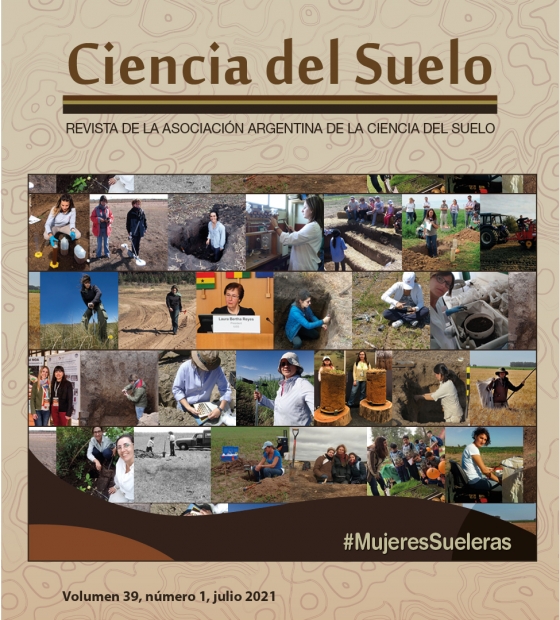Ver ítem
- xmlui.general.dspace_homeCentros Regionales y EEAsCentro Regional Buenos Aires SurEEA BalcarceArtículos científicosxmlui.ArtifactBrowser.ItemViewer.trail
- Inicio
- Centros Regionales y EEAs
- Centro Regional Buenos Aires Sur
- EEA Balcarce
- Artículos científicos
- Ver ítem
Delimitación de zonas de manejo en pasturas bajo diferentes niveles de nitrógeno y épocas del año.
Resumen
Los suelos ganaderos presentan una elevada heterogeneidad que provoca variabilidad en la producción de forraje. Por lo tanto, los objetivos de este trabajo fueron (a) determinar, a escala de lote, si la relación entre la conductividad eléctrica aparente (CEa) y propiedades edáficas, permite delimitar zonas de manejo potenciales (ZMP) y (b) evaluar si estas ZMP se relacionan, en primavera y otoño, con la variación espacial de la producción de forraje de
[ver mas...]
Los suelos ganaderos presentan una elevada heterogeneidad que provoca variabilidad en la producción de forraje. Por lo tanto, los objetivos de este trabajo fueron (a) determinar, a escala de lote, si la relación entre la conductividad eléctrica aparente (CEa) y propiedades edáficas, permite delimitar zonas de manejo potenciales (ZMP) y (b) evaluar si estas ZMP se relacionan, en primavera y otoño, con la variación espacial de la producción de forraje de una pastura de festuca alta creciendo con y sin limitantes de nitrógeno (N). En un lote de 5,75 ha que tenía implantada una pastura de festuca alta, se midió la CEa y en una grilla de 30 x 30 m se georreferenciaron 43 áreas de muestreo (AM) donde se determinaron propiedades edáficas (pH, textura, matéria orgânica, humedad gravimétrica (%) a 33 y 1500 kPa, salinidad, sodio, calcio, magnesio solubles y relación de absorción de sodio). Además, en cuatro rebrotes: primavera 2015, primavera 2016, otoño 2016 y otoño 2017 se marcaron dos parcelas en cada AM y se aplicaron dos tratamientos: N0 (sin aplicación de N) y N250 (250 kg ha-1 de N) para determinar la biomasa seca acumulada (BA). La salinidad y el porcentaje de arena fueron las variables que más explicaron la variabilidad de la Cea (R2= 0,67). Para el lote bajo estudio se delimitaron dos ZMP hallándose, en la BA promedio de primavera, interacción entre los factores de tratamiento ZMP y N (P = 0,02). Sin embargo, este comportamiento no se manifestó en la BA promedio de otoño (P > 0,05). En conclusión, mediante la CEa podrían delimitarse ZMP en primavera lo que facilitaría el manejo de pasturas de festuca alta. En cambio, no sería posible delimitar ambientes en otoño.
[Cerrar]
Soils for livestock production have a high heterogeneity that causes variability in forage production. The aims of this study were (i) to assess the relationship between ECa and soil.
Soils for livestock production have a high heterogeneity that causes variability in forage production. The aims of this study were (i) to assess the relationship between ECa and soil properties and then use this information to determine potential management zones (PMZ) and
[ver mas...]
Soils for livestock production have a high heterogeneity that causes variability in forage production. The aims of this study were (i) to assess the relationship between ECa and soil.
Soils for livestock production have a high heterogeneity that causes variability in forage production. The aims of this study were (i) to assess the relationship between ECa and soil properties and then use this information to determine potential management zones (PMZ) and (ii) evaluate if these PMZ are related to forage yield of tall fescue during different regrowth periods under contrasting levels of N availability. The ECa was measured in a 5.75 ha paddock that sustained a permanent pasture dominated by tall fescue. A 30 m by 30 m grid cell size was chosen and 43 sampling areas (SA) each 4 m2 in size, were georeferenced. In each SA soil samples were collected and analyzed for soil physicochemical properties such as pH, texture, organic matter, gravimetric soil water content (%) at 33 and 1500 kPa, salinity, soluble sodium, calcium and magnesium and sodium adsorption ratio . In addition, SA were divided into two experimental units of 1 m by 2 m, one of which was fertilised with 250 kg N ha 1 (N250) at the beginning of four regrowth periods (spring 2015, spring 2016, autumn 2016 and autumn 2017) and the other was not fertilized with N (N0). At the end of each regrowth period, the accumulated biomass (AB) was estimated. ECa was associated with salinity and sand percentage (R2 = 0,67). Two PMZ were delimited and the differences in AB were compared through analysis of variance. In spring, the average AB showed a significant PMZ x N interaction (P = 0.02). By contrast, the effects of PMZ on forage yield were not statistically significant in autumn (P > 0.05). In conclusion, in spring, the production of tall fescue can be managed by PMZs delimited by ECa. However, the delimitation of PMZs was not possible during autumn.
[Cerrar]

Autor
Cicore, Pablo Leandro;
Peralta, Nahuel Raúl;
Castro Franco, Mauricio;
Larrea, Gaston Emiliano;
Costa, José Luis;
Fuente
Ciencia del Suelo 39 (1) : 144-156 (Julio 2021)
Fecha
2021-07
Editorial
Asociación Argentina de la Ciencia del Suelo
ISSN
0326-3169
1850-2067
1850-2067
Formato
pdf
Tipo de documento
artículo
Palabras Claves
Derechos de acceso
Abierto
 Excepto donde se diga explicitamente, este item se publica bajo la siguiente descripción: Creative Commons Attribution-NonCommercial-ShareAlike 2.5 Unported (CC BY-NC-SA 2.5)
Excepto donde se diga explicitamente, este item se publica bajo la siguiente descripción: Creative Commons Attribution-NonCommercial-ShareAlike 2.5 Unported (CC BY-NC-SA 2.5)


